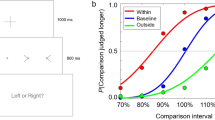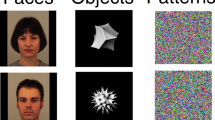Abstract
This paper describes the validation of the Interpersonal Perception Task (IPT), a new method for studying the process of social perception. The IPT is a videotape consisting of 30 scenes. Each scene is paired with a multiple-choice question about the interaction depicted in the scene. All scenes contain full-channel sequences of unscripted behavior and employ an objective criterion of accurate judgment. Five common types of social interaction are represented: status, intimacy, kinship, competition, and deception.
In the first study the IPT was administered to 438 subjects. Results indicated that subjects performed better than chance for 28 of the 30 scenes and that females performed better than males. A second study investigated the possibility that the people who appear in the IPT display idiosyncratic or unrepresentative behaviors. Three coders performed a scene-by-scene content analysis of the IPT, noting the presence or absence of behaviors which previous researchers have found to be associated with the five areas represented in the IPT. In all but one scene, coders found enough behavioral information to enable correct interpretation.
A third study employed a peer nomination procedure to explore the construct validity of the IPT. Subjects obtaining higher scores on the IPT were perceived by their friends as more socially skilled. Finally, in an investigation of the convergent and discriminant validity of the IPT, we found no relationship with a visual acuity task or the Machiavellian scale, a significant positive correlation with the Self-Monitoring Scale, a significant positive correlation with the Social Interpretations Task (SIT), and an even stronger positive correlation with those SIT items which measure the same areas as the IPT. Uses of the IPT to investigate the process and accuracy of interpersonal perception are discussed.
Similar content being viewed by others
References
Archer, D., & Akert, R. (1980). The encoding of meaning: A test of three theories of social interaction.Sociological Inquiry, 50 393–419.
Archer, D., & Akert, R.M. (1984). Problems of context and criterion in nonverbal communication: A new look at the accuracy issue. In M. Cook (Ed.)Issues in person perception. New York: Methuen.
Archer, D., & Akert, R.M. (1977). Words and everything else: Verbal and nonverbal cues in social interaction.Journal of Personality and Social Psychology, 35 443–449.
Briggs, S.R., & Cheek, J.M. (1988). On the nature of self-monitoring: Problems with assessment, problems with validity.Journal of Personality and Social Psychology, 54 663–678.
Briggs, S.R., Cheek, J.M., & Buss, A.H. (1980). An analysis of the self-monitoring scale.Journal of Personality and Social Psychology, 38 679–686.
Brown, R. (1986).Social psychology. New York: Free Press.
Buck, R. (1976). A test of nonverbal receiving ability: Preliminary studies.Human Communication Research 6 47–57.
Christie, R. & Geis, F.L. (1970).Studies in Machiavellianism. New York: Academic Press.
Costanzo, M. (1987).The production and testing of an instrument for assessing interpersonal perception processes. Unpublished manuscript, University of California, Santa Cruz.
Costanzo, M. & Philpott, J. (1986). Predictors of therapeutic talent in aspiring clinicians: A multivariate analysis.Psychotherapy, 23 363–369.
Cronbach, L.J. (1955).Processes affecting scores in ‘understanding of others’ and ‘assumed similarity’.Psychological Bulletin, 52 117–193.
DePaulo, B.M., Kenny, D.A., Hoover, C.W., Webb, W., & Oliver, P.V. (1987). Accuracy of person perception: Do people know what kinds of impressions they convey?Journal of Personality and Social Psychology, 52 303–315.
Ekman, P. & Friesen, W.V. (1974). Nonverbal behavior and psychopathology. In R.J. Friedman & H.M. Katz (Eds.),The psychology of depression: Contemporary theory and research. New York: John Wiley.
Estes, S.G. (1938). Judging personality from expressive behavior.Journal of Abnormal and Social Psychology, 33 217–236.
Funder, D.C. (1987). Errors and mistakes: Evaluating the accuracy of social judgment.Psychological Bulletin, 101 75–90.
Funder, D.C. & Harris, M.J. (1986). On the several facets of personality assessment: The case of social acuity.Journal of Personality, 54 528–550.
Gage, N.L. & Cronbach, L.J. (1955). Conceptual and methodological problems in interpersonal perception.Psychological Review, 62 411–422.
Gardner, H. (1985).Frames of mind: The theory of multiple intelligences. New York: Basic Books.
Harper, R.G. (1985). Power, dominance, and nonverbal behavior: An overview. In S.L. Ellyson & J.F. Dovidio (Eds.),Power, dominance, and nonverbal behavior. New York: Springer-Verlag.
Hall, J.A. (1984).Nonverbal sex differences: Communication accuracy and expressive style. Johns Hopkins University Press.
Hastie, R., & Rasinski, K.A. (1989). The concept of accuracy in social judgment. In D. Bar-Tal & A. Kruglanski (Eds.),The social psychology of knowledge. Cambridge, England: Cambridge University Press.
Hastorf, A.H., & Bender, I.E. (1952). A caution respecting the measurement of empathic ability.Journal of Abnormal and Social Psychology, 47 547–576.
Henley, N. (1977).Body politics. Englewood Cliffs, NJ: Prentice-Hall.
Heslin, R. & Patterson, M.L. (1982).Nonverbal behavior and social psychology. New York: Plenum Press.
Kagan, N.I. (1977).Affective sensitivity test: Validity and reliability. Paper presented at the meeting of the American Psychological Association, San Francisco.
Kenny, D.A., & Albright, L. (1987). Accuracy in interpersonal perception: A social relations analysis.Psychological Bulletin, 102 390–402.
Knapp, M.L. (1980).Essentials of nonverbal communication. New York: Holt, Rinehart & Winston.
Kleck, R.E. & Strenta, A. (1980). Perceptions of the impact of negatively valued physical characteristics on social interaction.Journal of Personality and Social Psychology, 39 861–873.
Maheady, L., Maitland, G., & Sainato, D. (1984). The interpretation of social interactions by mildly handicapped and nondisabled children.Journal of Special Education, 18 151–159.
Mill, J. (1984). High and low self-monitoring individuals: Their decoding skills and empathic expression.Journal of Personality, 52 372–338.
Patterson, M.L. (1983).Nonverbal behavior: A functional perspective. New York: Springer-Verlag.
Rosenthal, R. (1986). From unconscious experimenter bias to teacher expectancy effects. In J.B. Dusek (Ed.),Teacher expectancies. Hillsdale, NJ: Erlbaum.
Rosenthal, R., Archer, D., DiMatteo, M.R., Koivumaki, J.H., & Rogers, P. (1974). The language without words.Psychology Today, 8 44–50.
Rosenthal, R. & Benowitz, L.I. (1985). Sensitivity to nonverbal communication in normal, psychiatric, and brain-damaged samples. In P.D. Blanck, R.W. Buck, & R. Rosenthal (Eds.)Nonverbal communication in clinical context. University Park, PA.: Penn State Press.
Rosenthal, R., Hall, J.A., DiMatteo, M.R., Rogers, P.L., & Archer, D. (1979).Sensitivity to nonverbal communication: The PONS text. Baltimore: Johns Hopkins Press.
Scheflen, A.E. (1965). Quasi-courtship behavior in psychotherapy.Psychiatry, 28 245–267.
Snyder, M. (1974). Self-monitoring of expressive behavior.Journal of Personality and Social Psychology 30 526–537.
Snyder, M. (1986).Public appearances, private realities: The psychology of self-monitoring. New York: W.H. Freeman.
Snyder, M., Tanke, E.D., & Berscheid, E. (1977). Social perception and interpersonal behavior: On the self-fulfilling nature of social stereotypes.Journal of Personality and Social Psychology, 35 656–666.
Sternberg, R. (1984).Beyond I.Q.: A triarchic theory of human intelligence. Cambridge University Press.
Swann, W.B., Jr. (1984). Quest for accuracy in person perception: A matter of pragmatics.Psychological Review, 91 457–477.
Vernon, P.E. (1933). Some characteristics of the good judge of personality.Journal of Social Psychology, 4 42–57.
Word, C.O., Zanna, M.P., & Cooper, J. (1974). The nonverbal mediation of self-fulfilling prophesies in interracial interaction.Journal of Experimental Social Psychology, 10 109–120.
Zuckerman, M., DePaulo, B.M., & Rosenthal, R. (1981). Verbal and nonverbal communication of deception. In L. Berkowitz (Ed.)Advances in Experimental Social Psychology (Vol. 14, pp. 1–59). New York: Academic Press.
Zuckerman, M., & Przewuzman, S. (1979). Decoding and encoding facial expressions in preschool age children.Environmental Psychology and Nonverbal Behavior, 3 147–163.
Author information
Authors and Affiliations
Additional information
We wish to thank Elliot Aronson, Marti Hope Gonzales, Nancy Perrin, Thomas Pettigrew, Heather Smith and two anonymous reviewers for their helpful comments on earlier versions of this article. We would also like to thank Rebecca Rotberg for her help with this research.
Rights and permissions
About this article
Cite this article
Costanzo, M., Archer, D. Interperting the expressive behavior of others: The Interpersonal Perception Task. J Nonverbal Behav 13, 225–245 (1989). https://doi.org/10.1007/BF00990295
Issue Date:
DOI: https://doi.org/10.1007/BF00990295




